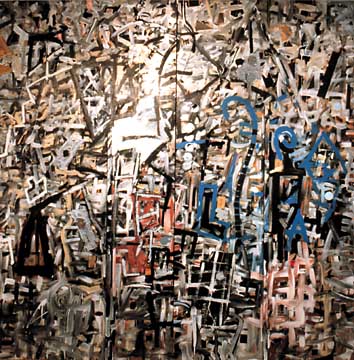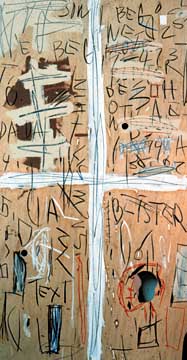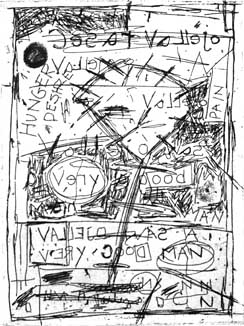 Necessary Work, mixed media, 96" x 92" |
Current Issue Highlights More Readings DA Home About Direct Art
Ernest Frazier: Random Deliberations by Barry Thorne Necessary Work, mixed media, 96" x 92" |
To Frazier, the Playhouse was more than just a building, it was a kindred spirit. Caught between a different time when a fantastic structure like it could be built for free with the volunteer labor of local loggers, artists and builders, and a modern world of hyper-consumerism and greed, the playhouse could not stand. This persistent reminder that art might serve a function more than that of an investment was too much for this investor to bear. It had to go, move aside, make room for progress.
Like the playhouse that he loved, Ernest Frazier is a man caught up in the grip of time. Frazier was born in 1942 on a farm in Duboise Crossroads, South Carolina. Six months later, his mother put him in a knapsack and hitchhiked to Harlem, New York City, seeking a better life for her son. Frazier spent his youth in Harlem, black and poor. Having no connection to the downtown art culture, he trained his muse with drawings inspired by comic books. For years the artist’s family saved, and at the age of 12 he moved with his parents to a cinderblock house in Greenburg, NY. The house was part of a development, many of which were promoted and sold to black families in the 1950s. Usually in reject locations, this one was built on a partially filled in swamp. Still it seemed an improvement over the city, and provided access to a better school in White Plains. From the age of 15 the muse of art took hold, and Frazier began to seriously paint. On leaving high school he enrolled in the School of Visual Arts. After one year Frazier was forced to leave the school. Even though the cost was low by today’s standards, work was difficult for a black man to find. Frazier’s family was poor and the tuition could not be found. Seeing no alternative, and hoping to return to the school with benefits, Frazier enrolled in the Marines.
Frazier was trained in the "Special Forces" and shipped off to South East Asia. He returned through Dante’s vortex to the icy lake of Hell and back - transformed. The spark and joy of youth was gone. A man returned, intense, impassioned and enraged. Nothing mattered anymore. His art was no longer a vocation, it was a necessity, a requirement, a last remaining link to the world in which we live.
 The Gospel, acrylic and oil stick on wood, 72" x 42" |
In 1963 Frazier returned to the School of Visual Arts and studied both the history and the practice of his art. His teachers in that era, Dore Ashton, George Ortman and Hilton Cramer, were in their prime. Like a sponge, Frazier absorbed it all. In 1969 he was ready for the public arena with his first solo exhibition at the State University of New York at Buffalo. Now living in downtown Manhattan, Frazier was immersed, painting profusely. After several group and solo exhibitions in the early 70s, Frazier was discovered, and in 1972 was featured in the Exhibition, "Contemporary Black Artists in America" at the Whitney Museum. A second exhibition at the Whitney in ’72, "Contemporary American Paintings" also featured Frazier’s work. The following year, 1973, Frazier was invited to exhibit in the Whitney Biennial and in 1974 he showed in the Whitney exhibition, "The Twentieth Century, 35 American Artists." With his work published in the catalogs for these exhibitions and reviewed in the respected magazines and journals of the day, Frazier was poised to become the Jackie Robinson of contemporary painting. A flurry of exhibitions, reviews and awards were soon to follow, but the art world was not yet ready to lay out the silver shoes of celebrity for a black man. In spite of his credentials, more than either Haring or Basquiat would come to have when they were snatched to fame, Frazier would not be touched by any major New York Dealer. Frazier had arrived, he was sitting in the chair with feet outstretched ready to receive the shoes. Yet at the moment when all reason did require the placement of those silver treads, the dealers got cold feet and placed them back in the box for another dozen years. The sun had risen on Frazier and grown to a glorious height, yet in a few short years, it somehow began to dim. Frazier saw the writing on the wall and in 1973 grouped his forces. Taking the proceeds from his sales, he purchased and restored an abandoned, red brick foundry building in Saugerties, NY, where he lives and works to this day.
Today Ernest Frazier is an intense figure. His eyes are sharp, his face intense with lines drawn by decades of struggle. Dreadlocks heavy and thick frame his face, the black of his hair now turning gray. His thoughts are random, his mind moves too quick to hold a single thought, yet each singular moment is precise and clear. Each perception is exact. No movement, no sound, no comment or event escapes his absorption and dissection. Underneath this is another layer, a heavy and profound sadness. Not a sadness stemming from life events or situations, but the type of weight only poetic souls can understand; a Karmic weight which bears the agony of ages past, lives cut short in pain, children lost in tragic grief.
 For Poet Cesare Vallejo, etching, 10" x 8" |
Like his paintings, Frazier’s living space is spartan and clean. Objects within it are placed with a random precision, a strange, haphazard utility. Inside the front door of the red brick structure is a small vestibule. On the floor to the left is a portrait of Frazier presented as a gift in 1985. It is a drawing/construction on wooden panels enclosed in a three-inch wooden frame. Self-standing, it sits on the floor and has not moved an inch in fourteen years. Seemingly, it was dropped at random on entering the space, then feeling it exactly placed, was never touched.
The first room inside is a large, open, loft like space with a row of large windows on one wall. A round table to the right holds a half dozen or so large cactus plants. The cactus plant, ornery and tough on the outside, yet delicate and fragile inside, has a symbolic importance to the artist. Against the back wall is a shelf with a stereo, on the other side of the room facing the windows is a small table and lone chair, the only furniture in the room. About the room, in scattered but seemingly ordered piles, are framed works on paper. Piles are leaned up against the walls and stacked against the two support columns in the center of the room. The function of this room seems to be artistic preservation. A double door sized opening at the back of this room leads to a smaller room with two bookshelves, a small TV, a woodstove, a small table and one antique cushioned chair. The chair, comfortable and soft, seems out of place. I learned that this chair, which replaced a hard wooden one, was recently acquired after lengthy deliberation. To the left is a large kitchen with a single round table and two stool like chairs. The counter surfaces are empty. A few liquor bottles and two pint bottles of Guinness the artist purchased several months ago are lined up on the floor against the wall. I get the feeling that these Guinness bottles will remain in this exact location unopened for many years to come. At the back of the house is the studio. A large rectangular room, the studio is separated from the large windows that light the rest of the house, and is the only room that has a feeling of weight and darkness. This feeling is somehow accentuated by the floor, which is a block of concrete three feet thick. Here the artist creates his work.
 Sphinx, acrylic and crayon on paper, 22" x 30" |
Fraziers work, like his mind and living space, reflects a random yet deliberate use of space and form. Working primarily on a white surface, which the artist prefers for it’s very whiteness and absence of form, the work begins with a sudden application of black marks. Whether the work begins with chalk, charcoal or paint does not matter. What matters is the absence of thought, and the presence of what we can only call "the impulse." The impulse comes and goes at random and without it nothing of importance will be accomplished. The marks, beginning in black and later becoming color, form patterns that have symbolic importance to the artist and can reflect particular subjects. The geometric patterns may relate to physical objects such as African shields, faces or carvings, or may create a unique modernist tribalism in themselves. The variation in Fraziers work is endless and reflects the speed with which the artists mind leaps between various subjects. Yet within each subject, as within each painting, there is a clarity and pureness of perception. His work is random, yet deliberate, spontaneous, yet exact. Like colliding atoms in space, yet driven not by quantum powers - but by pure, intense emotional force.
Frazier’s career is by no means over. His bibliography and resume of over seventy exhibitions during the past 28 years is extensive, his collections impressive. In spite of this I leave Frazier’s house in contradiction, exhilarated by the work and yet with an underlying sadness. Here is one artist who had everything in place. Before Jean Michael Basquait, before Haring or Clemente, Frazier had arrived. Was the artworld not ready for his blackness? Was it the intensity of his personality, perhaps his social placement, or his failure to wait the tables of Mr. Chows? Who can say. What we know is that Ernest Frazier, with the same tenacious presence as the Woodstock Playhouse, will not be moved. He sits here still, older now and in a cushioned chair, yet with feet outstretched, waiting for those silver shoes. If he should die before those shoes are passed his way his feet will stick out from the grave into the guilty face of time and beckon, bones bleached white, until those shoes are placed where they belong.
~~~~~~~~~~~~~~~~~~
Current Issue Highlights More Readings DA Home About Direct Art